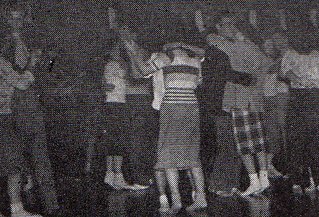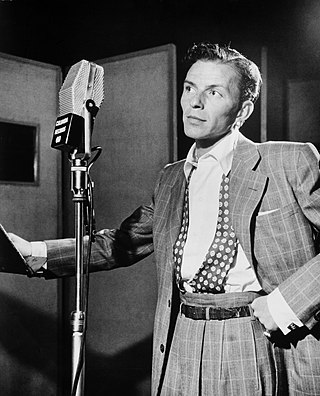Rock and roll is a genre of popular music that evolved in the United States during the late 1940s and early 1950s. It originated from African American music such as jazz, rhythm and blues, boogie-woogie, electric blues, gospel, jump blues, as well as country music. While rock and roll's formative elements can be heard in blues records from the 1920s and in country records of the 1930s, the genre did not acquire its name until 1954.
Teen magazines are magazines aimed at teenage readers. They usually consist of gossip, news, fashion tips and interviews and may include posters, stickers, small samples of cosmetics or other products and inserts.
Traditional pop is Western pop music that generally pre-dates the advent of rock and roll in the mid-1950s. The most popular and enduring songs from this era of music are known as pop standards or American standards. The works of these songwriters and composers are usually considered part of the canon known as the "Great American Songbook". More generally, the term "standard" can be applied to any popular song that has become very widely known within mainstream culture.

A teen idol is a celebrity with a large teenage fan base. Teen idols are generally young but are not necessarily teenagers themselves. An idol's popularity may be limited to teens, or may extend to all age groups.

Doo-wop is a genre of rhythm and blues music that originated in African-American communities during the 1940s, mainly in the large cities of the United States, including New York, Philadelphia, Pittsburgh, Chicago, Baltimore, Newark, Detroit, Washington, D.C., and Los Angeles. It features vocal group harmony that carries an engaging melodic line to a simple beat with little or no instrumentation. Lyrics are simple, usually about love, sung by a lead vocal over background vocals, and often featuring, in the bridge, a melodramatically heartfelt recitative addressed to the beloved. Harmonic singing of nonsense syllables is a common characteristic of these songs. Gaining popularity in the 1950s, doo-wop was "artistically and commercially viable" until the early 1960s, but continued to influence performers in other genres.

Teenage pregnancy, also known as adolescent pregnancy, is pregnancy in a female adolescent or young adult under the age of 20. Worldwide, pregnancy complications are the leading cause of death for women and girls 15 to 19 years old. The definition of teenage pregnancy includes those who are legally considered adults in their country. The WHO defines adolescence as the period between the ages of 10 and 19 years. Pregnancy can occur with sexual intercourse after the start of ovulation, which can happen before the first menstrual period (menarche). In healthy, well-nourished girls, the first period usually takes place between the ages of 12 and 13.

In Japanese culture, Kogal refers to the members of the Gyaru subculture who are still in high school and who incorporate their school uniforms into their dress style. These high school girls are characterized by the typical bleached hair, make-up, shortened skirts, and wearing of loose socks. The word kogal is anglicized from kogyaru, a contraction of kōkōsei gyaru.

Many musical styles flourished and combined in the 1940s and 1950s, most likely because of the influence the radio had in creating a mass market for music. World War II caused great social upheaval, and the music of this period shows the effects of that upheaval.
Teen pop is a subgenre of pop music that is created, marketed and oriented towards preteens and teenagers. Teen pop incorporates different subgenres of pop music, as well as elements of R&B, dance, electronic, hip hop and rock, while the music of girl groups, boy bands, and acts like Britney Spears, NSYNC, Backstreet Boys are sometimes referred to as pure pop. Typical characteristics of teen pop music include Auto-Tuned or pitch-corrected vocals, choreographed dances, emphasis on visual appeal, lyrics focused on love, relationships, dancing, partying, friendship, puppy love and repeated chorus lines. Its lyrics also incorporate sexual innuendo. Teen pop singers often cultivate an image of a girl next door/boy next door.

A sock hop or sox hop, often also called a record hop or just a hop, was an informal sponsored dance event for teenagers in mid-20th-century North America, featuring popular music.

A crooner is a singer that performs with a smooth, intimate style that originated in the 1920s. The style was made possible by better microphones which picked up quieter sounds and a wider range of frequencies, allowing the singer to access a more dynamic range. This suggestion of intimacy was supposedly wildly attractive to women, especially younger ones such as teenage girls, known at the time as "bobby soxers". The crooning style developed out of singers who performed with big bands, and reached its height in the 1940s to late 1960s.
A teenybopper is a young teenager who follows adolescent trends in music, fashion, and culture. The term may have been coined by marketing professionals and psychologists, later becoming a subculture of its own. The term was introduced in the 1950s to refer to teenagers who mainly listened to popular music and/or rock and roll and not much else. Teenybopper became widely used again in the late 1960s and early 1970s, following an increase in the marketing of pop music, teen idols and fashions aimed specifically at younger girls, generally 10–15 years old.

The beach party film is an American film genre of feature films which were produced and released between 1963 and 1968, created by American International Pictures (AIP), beginning with their surprise hit, Beach Party, in July 1963. With this film, AIP is credited with creating the genre. In addition to the AIP films, several contributions to the genre were produced and released by major and independent studios alike. According to various sources, the genre comprises over 30 films, with the lower-budget AIP films being the most profitable.

Bobby socks are a style of women's socks. They are white and worn ankle-length or collected at the ankle, instead of being rolled up fully extended on the leg. The term is derived from the socks being worn "bobbed", meaning around the ankle.
Teenage rebellion is a part of social development in adolescents in order for them to develop an identity independent from their parents or family and a capacity for independent decision-making. They may experiment with different roles, behaviors, and ideologies as part of this process of developing an identity. Teenage rebellion has been recognized within psychology as a set of behavioral traits that supersede class, culture, or race; some psychologists, however, have disputed the universality of the phenomenon. According to Terror Management Theory, the child's allegiance to parental authority and worldviews can weaken after the discovery that parents, like themselves and everyone else, are mortal. This realization creates an unconscious need for security that is broader than what the parents alone provide. This can lead to new cultural allegiances, in the search for a more enduring sense of meaning. Teenagers seek to perceive themselves a valued contributor to aspects of culture that more convincingly outlive or transcend the mortal individual's lifespan. However, since the parents also instill their cultural beliefs onto the child, if the child does not come to associate their parents' mortality with their cultural beliefs, the chances of rebellion decrease.
The sexuality of US adolescents includes their feelings, behaviors and development, and the place adolescent sexuality has in American society, including the response of the government, educators, parents, and other interested groups.

Since the beginning of his career, American singer Elvis Presley has had an extensive cultural impact. According to Rolling Stone, "It was Elvis who made rock 'n' roll the international language of pop." The Rolling Stone Encyclopedia of Rock & Roll describes Presley as "an American music giant of the 20th century who single-handedly changed the course of music and culture in the mid-1950s". His recordings, dance moves, attitude and clothing came to be seen as embodiments of rock and roll. His music was heavily influenced by African-American blues, Christian gospel, and Southern country. In a list of the greatest English language singers, as compiled by Q magazine, Presley was ranked first, and second in the list of greatest singers of the 20th century by BBC Radio. Some people claim that Presley created a whole new style of music: "It wasn't black, wasn't white, wasn't pop or wasn't country—it was different." As most singers in his time created music geared for adults, he gave teens music to grow up with.
A teen situation comedy, or teen sitcom, is a subgenre of comedic television program targeted towards young people. In general, these type of programs focus primarily on characters between 11 and 19 years of age and routinely feature characters involved in humorous situations, and often focus on the characters' family and social lives. The primary plot of each episode often involves the protagonist(s) the program centers on, while secondary plotlines often focus on the character(s') parents, siblings or friends, although the secondary characters may sometimes also or instead be involved in the episode's main plot.
For music from an individual year in the 1940s, go to 40 | 41 | 42 | 43 | 44 | 45 | 46 | 47 | 48 | 49

Bobby Sox Idol is a calypso song by Trinidadian musician Wilmoth Houdini about singer Frank Sinatra.













